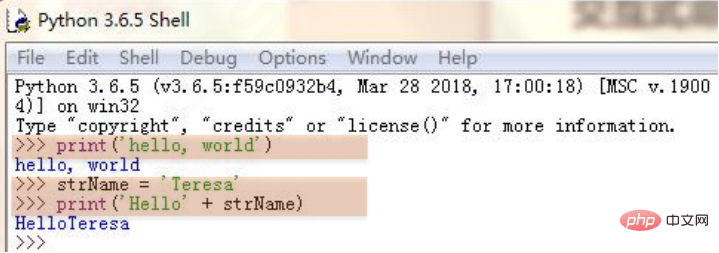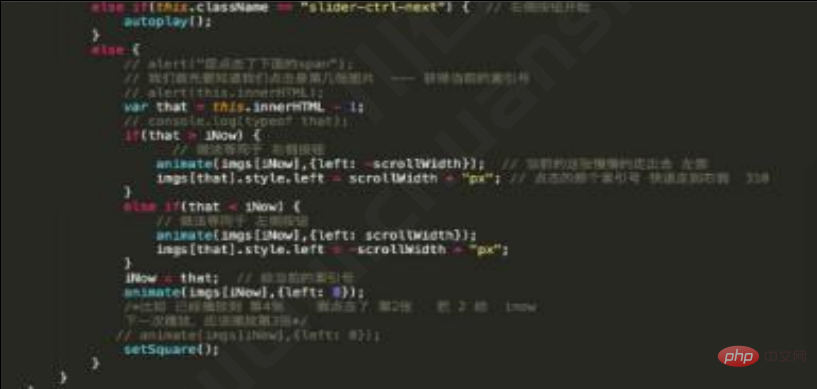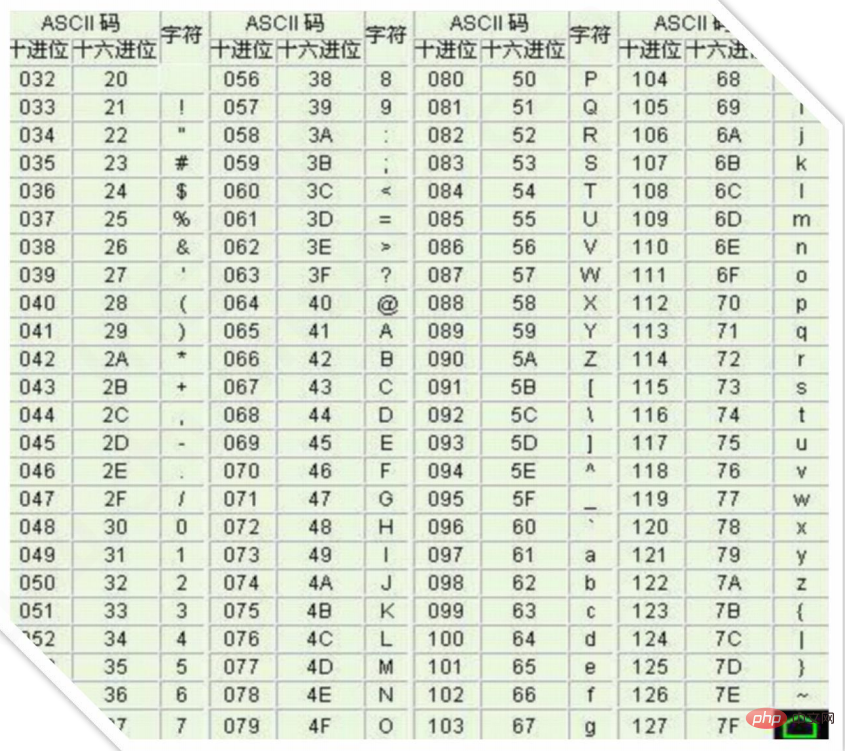 Backend Development
Backend Development
 Python Tutorial
Python Tutorial
 Automated testing: several common programming patterns in Python
Automated testing: several common programming patterns in Python
Automated testing: several common programming patterns in Python

This chapter updates the content related to "Python syntax specifications and data types", mainly to let everyone understand what types of programming modes Python has, master the basic syntax of Python, and understand How to output and the basic application of command line parameters. After understanding the data types of Python, you can do more related operations.
Common programming patterns
①Python interactive command programming.
②Python script programming.
③Chinese encoding processing.
1. Interactive command programming mode
The interactive command programming mode is a typical line-by-line reading execution mode.
This programming mode is a typical application when the program has only one line or less.
The following figure uses the PythonIDLE editor for programming, and the programming mode of this editor is a typical interactive command encoding symbol.
>>> is the prompt for entering interactive commands. Each time you press Enter after completing the input, the command will be executed by the Python parser.

2. Script programming mode
When we need to write more complex or large sections of code, imperative programming is not convenient enough.
Therefore, Python provides a script programming mode. You can create a script file with the suffix *.py and write a large amount of code into the file, which facilitates the maintenance and update of the code. You can then use interactive commands or IDE tools to run it.

3. Character programming
String is a data type. However, strings have a special encoding problem.
Because computers can only process numbers, if you want to process text, you must first convert the text into numbers before processing.
Supplement: History of the development of character encoding
The earliest computers used 8 bits as a byte during design. Therefore, the largest integer that can be represented by a byte That is 255 (binary 11111111 = decimal 255). If you want to represent a larger integer, you must use more bytes. For example, the maximum integer that can be represented by two bytes is 65535, and the maximum integer that can be represented by 4 bytes is 4294967295.
Since the computer was invented by Americans, only 127 characters were encoded into the computer at first, that is, uppercase and lowercase English letters, numbers and some symbols. This encoding table is called ASCII encoding, such as uppercase letters The code for the letter A is 65, and the code for the lowercase letter z is 122.

Extension: unicode character set
The reason why Python3 can solve the Chinese garbled problem well is that it uses unicode for all strings Character Encoding.
● Unicode unifies all languages into one set of codes so that there will be no garbled characters.
● Unicode is also constantly developing, but the most commonly used one is to use two bytes to represent a character (if you encounter a very rare character, you need 4 bytes). Most operating systems and most programming languages we see now support unicode.
ASCII encoding is 1 byte, while Unicode encoding is usually 2 bytes.
Extension: UTF-8 character set
New problems arise again: If unified into Unicode encoding, the garbled code problem will disappear. However, if the text you write is basically all in English, Unicode encoding requires twice as much storage space as ASCII encoding, which is very uneconomical in terms of storage and transmission.
The birth of the solution: The UTF-8 encoding that converts Unicode encoding into "variable length encoding" appeared again.
● UTF-8 encoding encodes a Unicode character into 1-6 bytes according to different number sizes. Commonly used English letters are encoded into 1 byte, and Chinese characters are usually 3 bytes. Only Very rare characters will be encoded into 4-6 bytes.
● If the text you want to transmit contains a large number of English characters, using UTF-8 encoding can save space.
● UTF-8 encoding has an additional benefit, that is, ASCII encoding can actually be regarded as part of UTF-8 encoding. Therefore, a large number of historical legacy software that only supports ASCII encoding can be encoded in UTF-8 Keep working while coding.
Special note: Unicode encoding is used uniformly in computer memory.
python3 character encoding
In the Python3 version, strings are encoded in Unicode, which means that Python strings support multiple languages.
For the encoding of a single character, Python provides the ord() function to obtain the decimal integer representation of a single character, and the chr() function to convert the encoding into the corresponding character.
Example:
1 2 3 4 5 6 7 8 |
|
Python source code is also a text file, so when your source code contains Chinese, you need to specify the UTF-8 encoding when saving the source code. When the Python interpreter reads source code, in order for it to be read in UTF-8 encoding, we usually write this line at the beginning of the file.
1 |
|
The comment is to tell the Python interpreter to read the source code according to UTF-8 encoding. Otherwise, the Chinese output you write in the source code may be garbled.
The above is the detailed content of Automated testing: several common programming patterns in Python. For more information, please follow other related articles on the PHP Chinese website!

Hot AI Tools

Undresser.AI Undress
AI-powered app for creating realistic nude photos

AI Clothes Remover
Online AI tool for removing clothes from photos.

Undress AI Tool
Undress images for free

Clothoff.io
AI clothes remover

Video Face Swap
Swap faces in any video effortlessly with our completely free AI face swap tool!

Hot Article

Hot Tools

Notepad++7.3.1
Easy-to-use and free code editor

SublimeText3 Chinese version
Chinese version, very easy to use

Zend Studio 13.0.1
Powerful PHP integrated development environment

Dreamweaver CS6
Visual web development tools

SublimeText3 Mac version
God-level code editing software (SublimeText3)

Hot Topics
 1657
1657
 14
14
 1415
1415
 52
52
 1309
1309
 25
25
 1257
1257
 29
29
 1230
1230
 24
24
 PHP and Python: Different Paradigms Explained
Apr 18, 2025 am 12:26 AM
PHP and Python: Different Paradigms Explained
Apr 18, 2025 am 12:26 AM
PHP is mainly procedural programming, but also supports object-oriented programming (OOP); Python supports a variety of paradigms, including OOP, functional and procedural programming. PHP is suitable for web development, and Python is suitable for a variety of applications such as data analysis and machine learning.
 Choosing Between PHP and Python: A Guide
Apr 18, 2025 am 12:24 AM
Choosing Between PHP and Python: A Guide
Apr 18, 2025 am 12:24 AM
PHP is suitable for web development and rapid prototyping, and Python is suitable for data science and machine learning. 1.PHP is used for dynamic web development, with simple syntax and suitable for rapid development. 2. Python has concise syntax, is suitable for multiple fields, and has a strong library ecosystem.
 PHP and Python: A Deep Dive into Their History
Apr 18, 2025 am 12:25 AM
PHP and Python: A Deep Dive into Their History
Apr 18, 2025 am 12:25 AM
PHP originated in 1994 and was developed by RasmusLerdorf. It was originally used to track website visitors and gradually evolved into a server-side scripting language and was widely used in web development. Python was developed by Guidovan Rossum in the late 1980s and was first released in 1991. It emphasizes code readability and simplicity, and is suitable for scientific computing, data analysis and other fields.
 Python vs. JavaScript: The Learning Curve and Ease of Use
Apr 16, 2025 am 12:12 AM
Python vs. JavaScript: The Learning Curve and Ease of Use
Apr 16, 2025 am 12:12 AM
Python is more suitable for beginners, with a smooth learning curve and concise syntax; JavaScript is suitable for front-end development, with a steep learning curve and flexible syntax. 1. Python syntax is intuitive and suitable for data science and back-end development. 2. JavaScript is flexible and widely used in front-end and server-side programming.
 How to run sublime code python
Apr 16, 2025 am 08:48 AM
How to run sublime code python
Apr 16, 2025 am 08:48 AM
To run Python code in Sublime Text, you need to install the Python plug-in first, then create a .py file and write the code, and finally press Ctrl B to run the code, and the output will be displayed in the console.
 Where to write code in vscode
Apr 15, 2025 pm 09:54 PM
Where to write code in vscode
Apr 15, 2025 pm 09:54 PM
Writing code in Visual Studio Code (VSCode) is simple and easy to use. Just install VSCode, create a project, select a language, create a file, write code, save and run it. The advantages of VSCode include cross-platform, free and open source, powerful features, rich extensions, and lightweight and fast.
 How to run python with notepad
Apr 16, 2025 pm 07:33 PM
How to run python with notepad
Apr 16, 2025 pm 07:33 PM
Running Python code in Notepad requires the Python executable and NppExec plug-in to be installed. After installing Python and adding PATH to it, configure the command "python" and the parameter "{CURRENT_DIRECTORY}{FILE_NAME}" in the NppExec plug-in to run Python code in Notepad through the shortcut key "F6".
 Can visual studio code be used in python
Apr 15, 2025 pm 08:18 PM
Can visual studio code be used in python
Apr 15, 2025 pm 08:18 PM
VS Code can be used to write Python and provides many features that make it an ideal tool for developing Python applications. It allows users to: install Python extensions to get functions such as code completion, syntax highlighting, and debugging. Use the debugger to track code step by step, find and fix errors. Integrate Git for version control. Use code formatting tools to maintain code consistency. Use the Linting tool to spot potential problems ahead of time.



